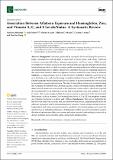| dc.description.abstract | Background
Linear growth faltering continues to negatively affect children in low- and middle-income countries and is associated with poor cognitive, developmental, and educational outcomes. Laboratory and observational data suggest that aflatoxin (AF) is a contributor to stunting.
Objective
The Mycotoxin Mitigation Trial was a cluster-randomized, community-based 2-group trial conducted in Kongwa District, Tanzania, between 2018 and 2020. The trial assessed whether a 12-mo intervention to reduce AF consumption increased length-for-age z-scores (LAZ) at 18 mo.
Methods
Low-AF maize and groundnut flours were provided to the intervention group each month; skin lotion was distributed to the control group monthly. Infant and young child feeding education was delivered equally in 52 health facilities (clusters). Anthropometry and the AF blood biomarker serum AF-albumin (AF-alb) were assessed at 6, 12, and 18 mo of age. Outcomes were analyzed as intention-to-treat and per-protocol using linear mixed-effects models.
Results
Two thousand eight hundred forty-two maternal–infant dyads were recruited into the study. The intervention did not create a contrast in AF-alb. At 18 mo, 36% (n = 186/520) of infants had detectable levels of AF-alb compared with 54% (n = 195/364) at baseline, with no difference between groups. Mean LAZ in the intervention group at 18 mo was −1.83 (n = 1231, 95% CI: −1.93, −1.73) compared to −1.90 (n = 1287, 95% CI: −1.99, −1.82) in the control group (P = 0.28).
Conclusions
An intervention to reduce AF exposure did not alter AF-alb nor anthropometric measures between treatment groups. Drought and agricultural data indicated less favorable conditions for toxin production, resulting in low levels of exposure in both trial arms. Annual, seasonal, and geographic heterogeneity of AF contamination make it difficult to study in an ethically designed trial. Our formative research and early trial data indicate that stunting and intermittent AF exposure continue to be a problem in this region. However, the low-AF exposure levels during the trial led to inconclusive results. | en_US |

